One Year
Sleepy morning on December 16, 2020. All lunchbag art photos/Alisha Kerlin.
By Alisha Kerlin
This year is the last year of my thirties. This is the year the museum hit its stride. This is the year my daughter is five. This is the year I adopted a giant puppy and finally planted a garden. This is the year I put down roots.
This is also the year artist Barbara Ess left the earth. She was my teacher at Bard College where I received an MFA in painting 14 years ago.
“I’m interested in daily life and believe that the key to the mysteries of existence are there. You don’t have to look to the sky or go to a psychic—our daily life holds all the answers. But it’s hard to recognize them—at least I have a hard time sorting it all out. I wish I knew what I was supposed to be doing having a life on earth.” Barbara Ess
This year, daily life isn’t what we expected it to be, yet I agree with Ess that the key to the mysteries of existence are there. Despite the fact that we weathered and mourned changes to our daily routines because of the pandemic shutdown, I have experienced tremendous growth as a mother, leader, and artist.
I enjoy my role as “mom,” but it was hard to work from home with a busy only child. I am thankful that my daughter Faye is one of the few children who was able to return to in-person preschool in 2020. There were many changes to her classroom day and structure, yet one of the seemingly minor changes became a record of daily life through the eyes of a five-year-old living through a pandemic. Lunches were to be sent to school in little brown paper sacks labeled with date, child’s name, and contents.
"What do you want on your lunch bag today?" Almost all of the subject matter for the bags comes from that question. Faye tells me what to draw. I drink my coffee, and her father makes her lunches. This activity is compressed for both space and time—screeching kettles, pancakes, hair brushing, getting dressed, shoes on the wrong feet, and BRUSH YOUR TEETH. Quick sketches of our goofy dog and water-obsessed calico led to an unintended series.
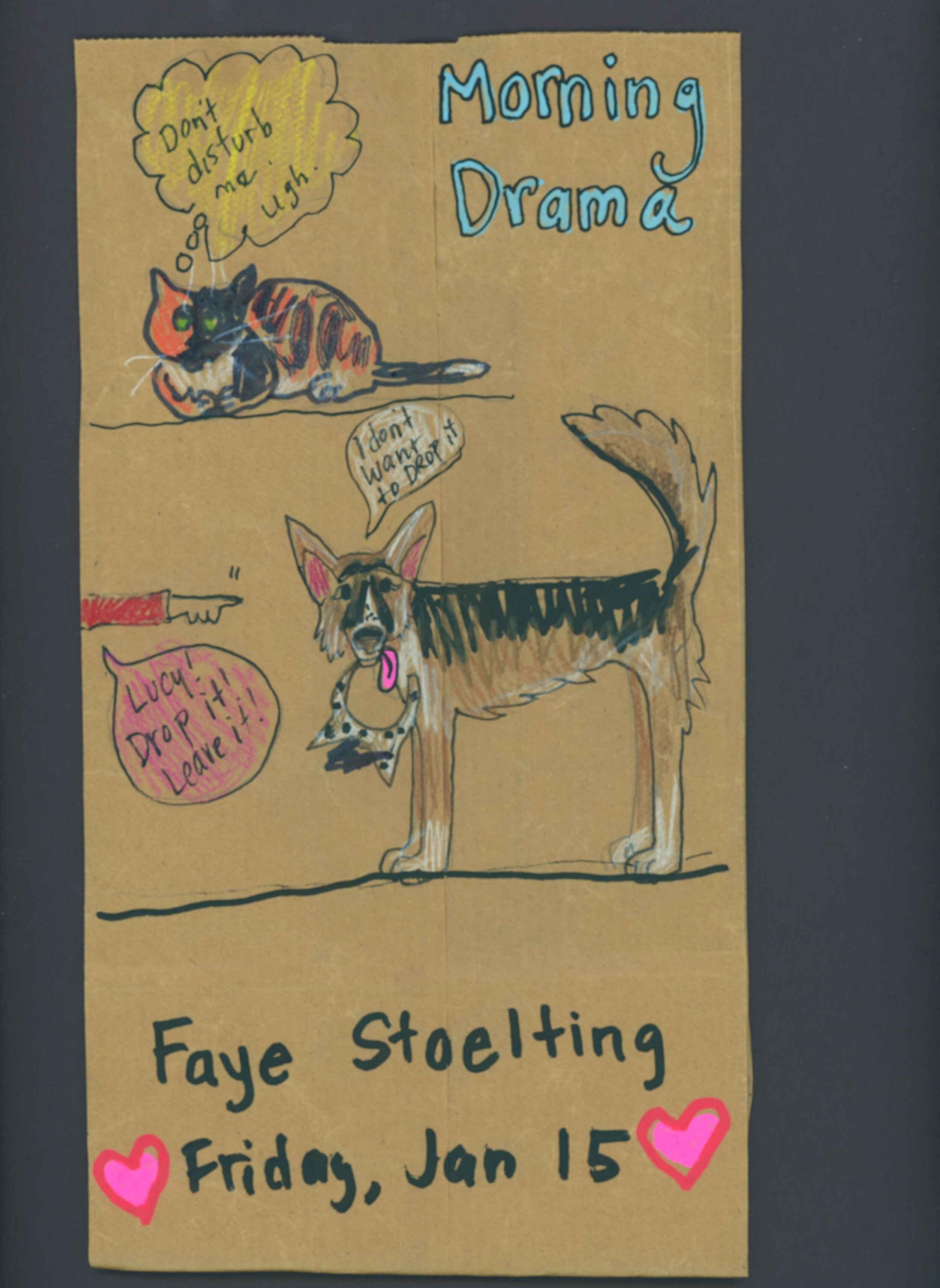
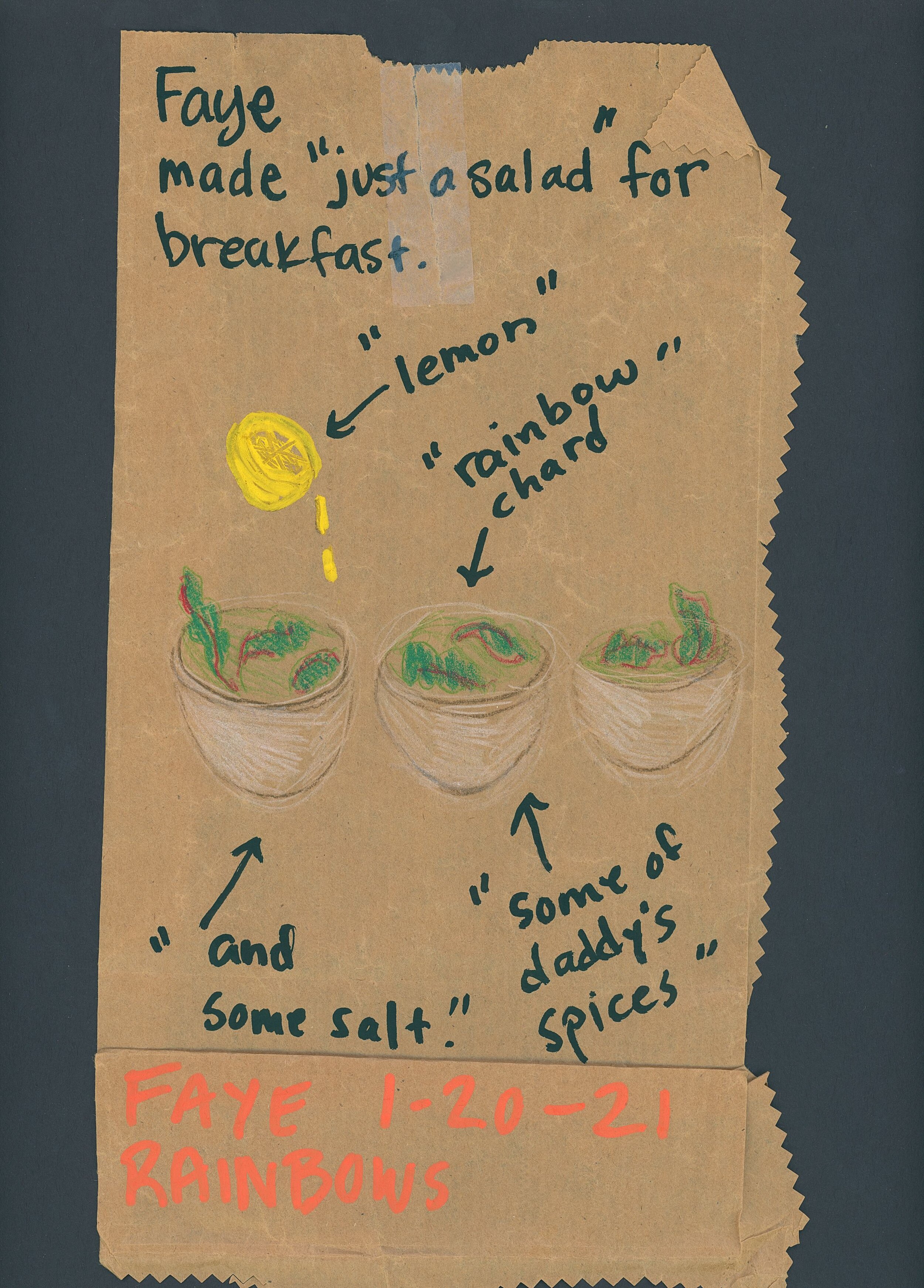
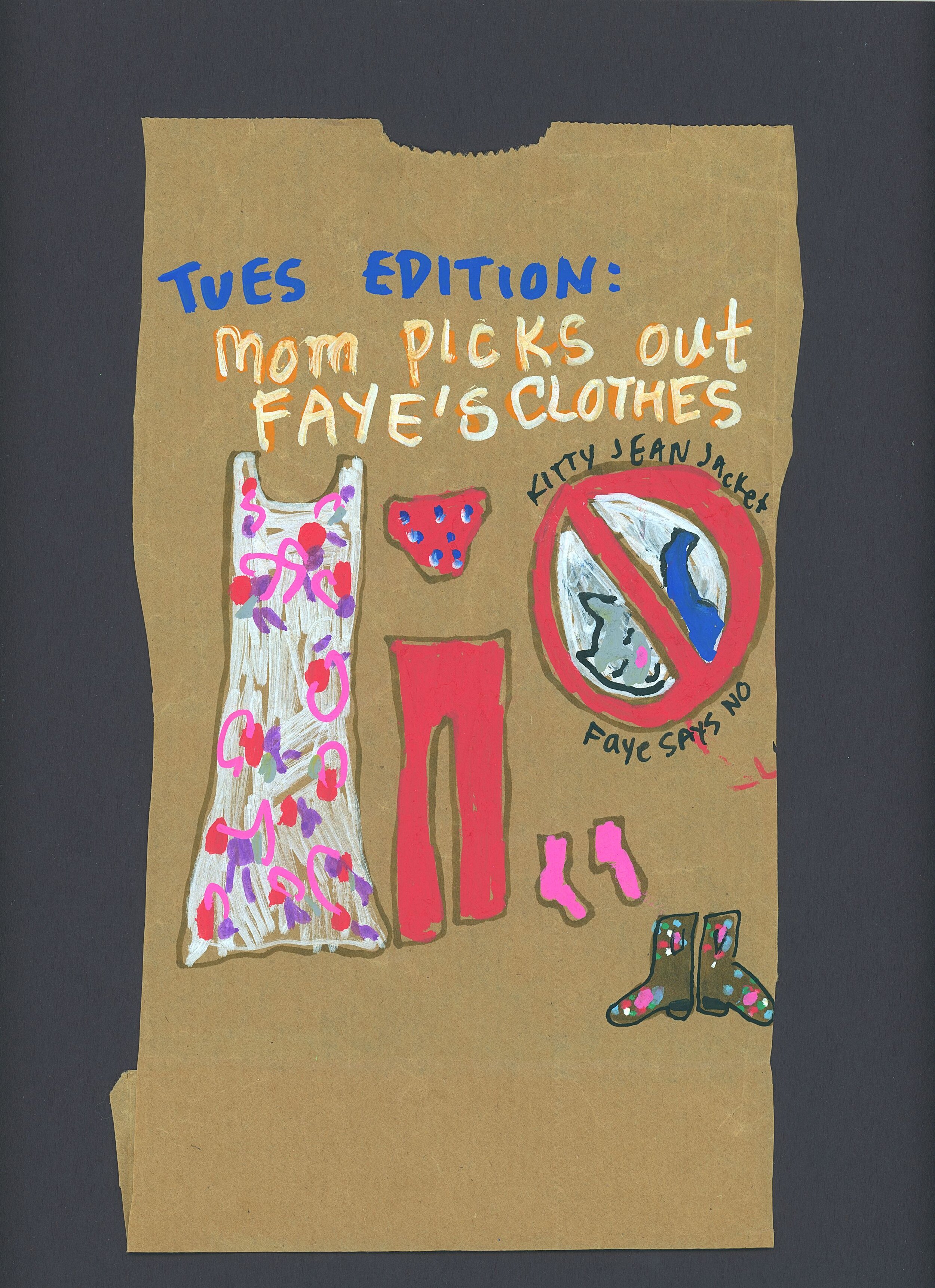
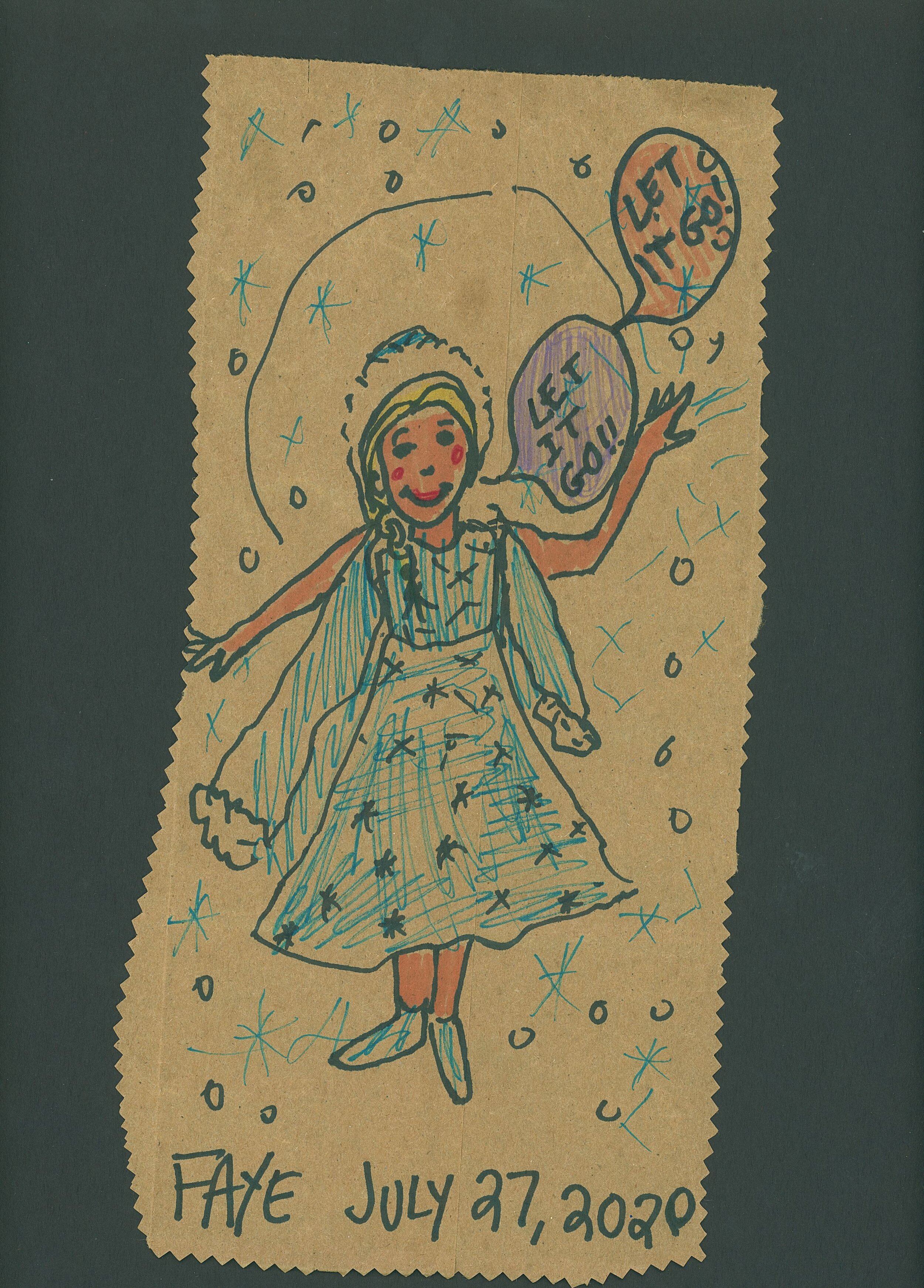
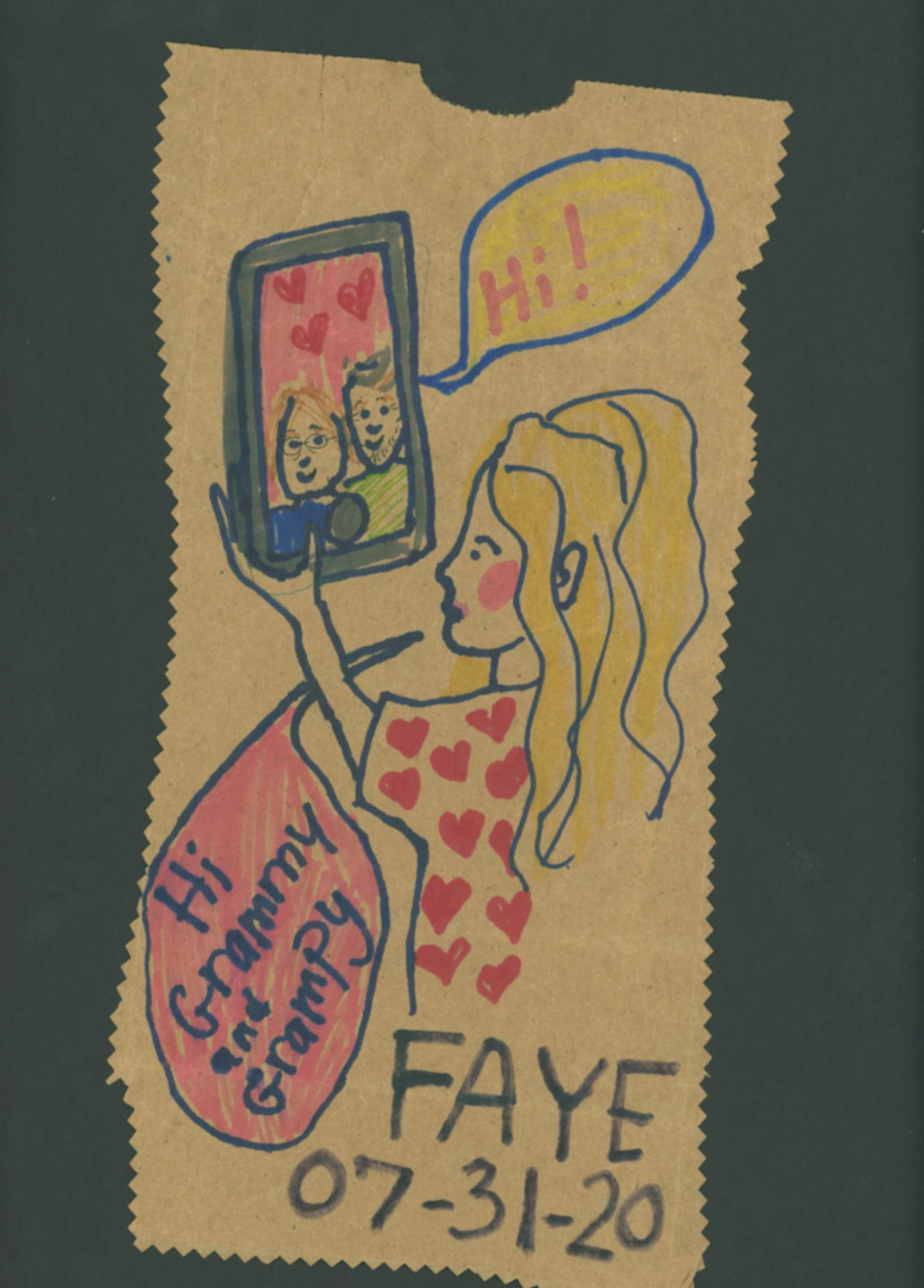
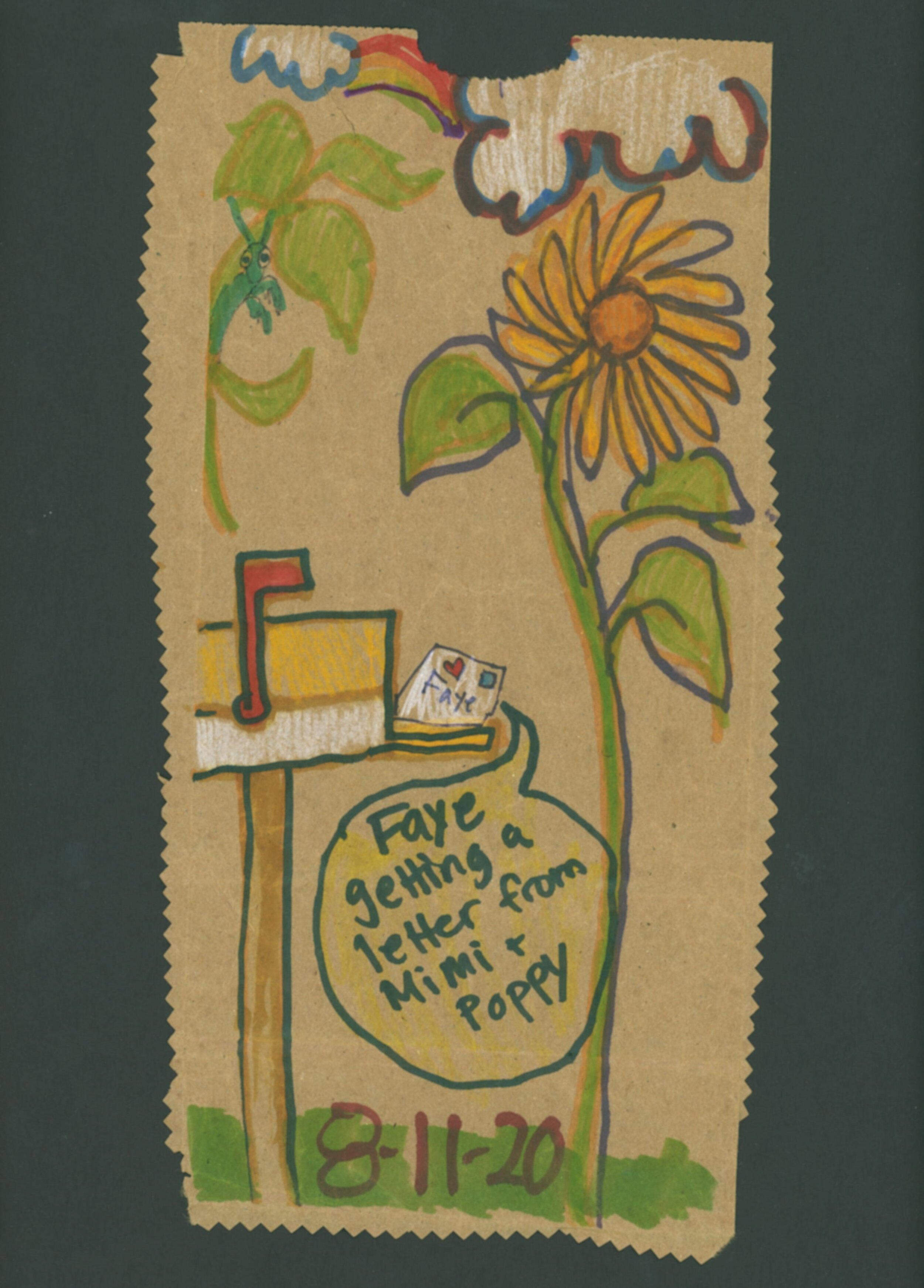
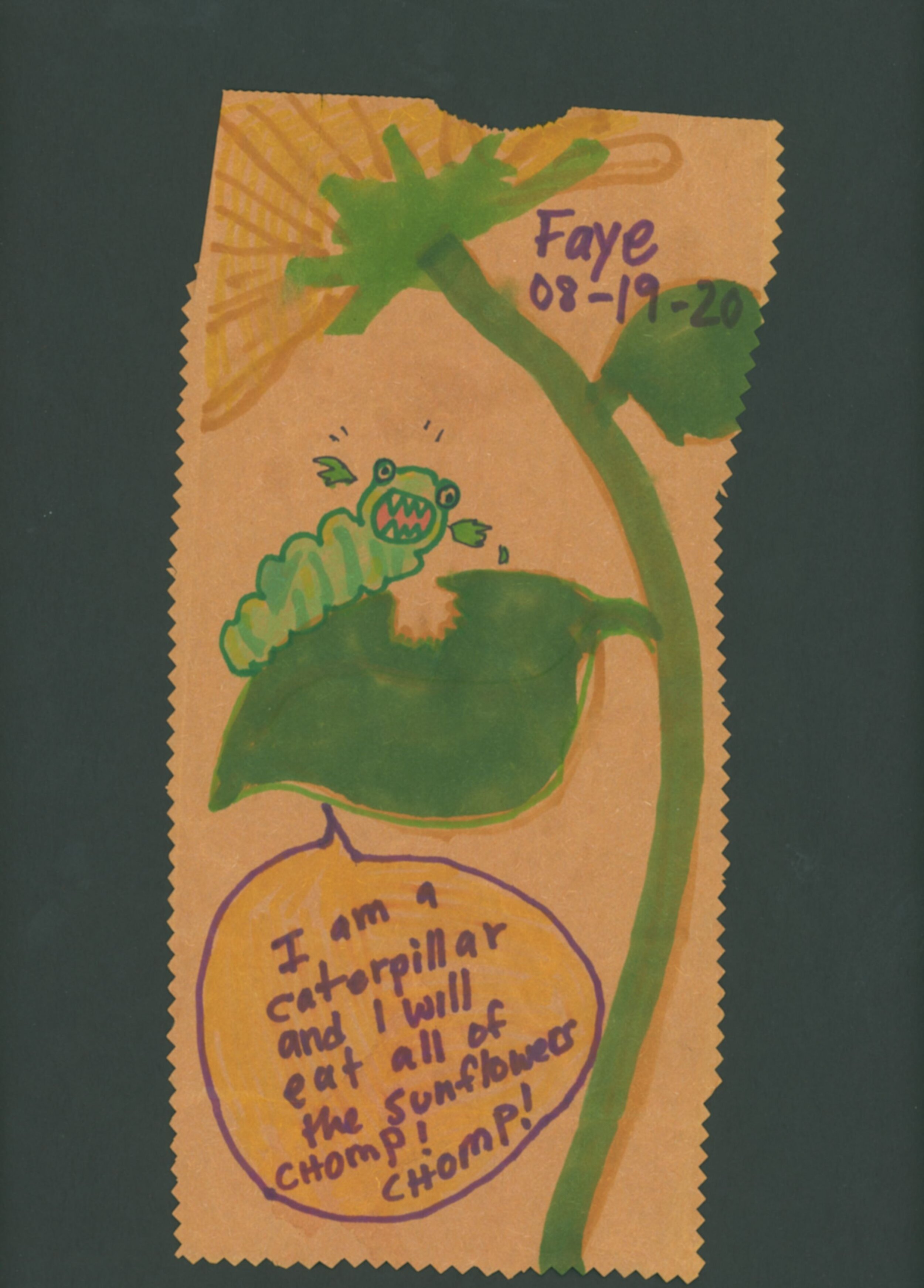
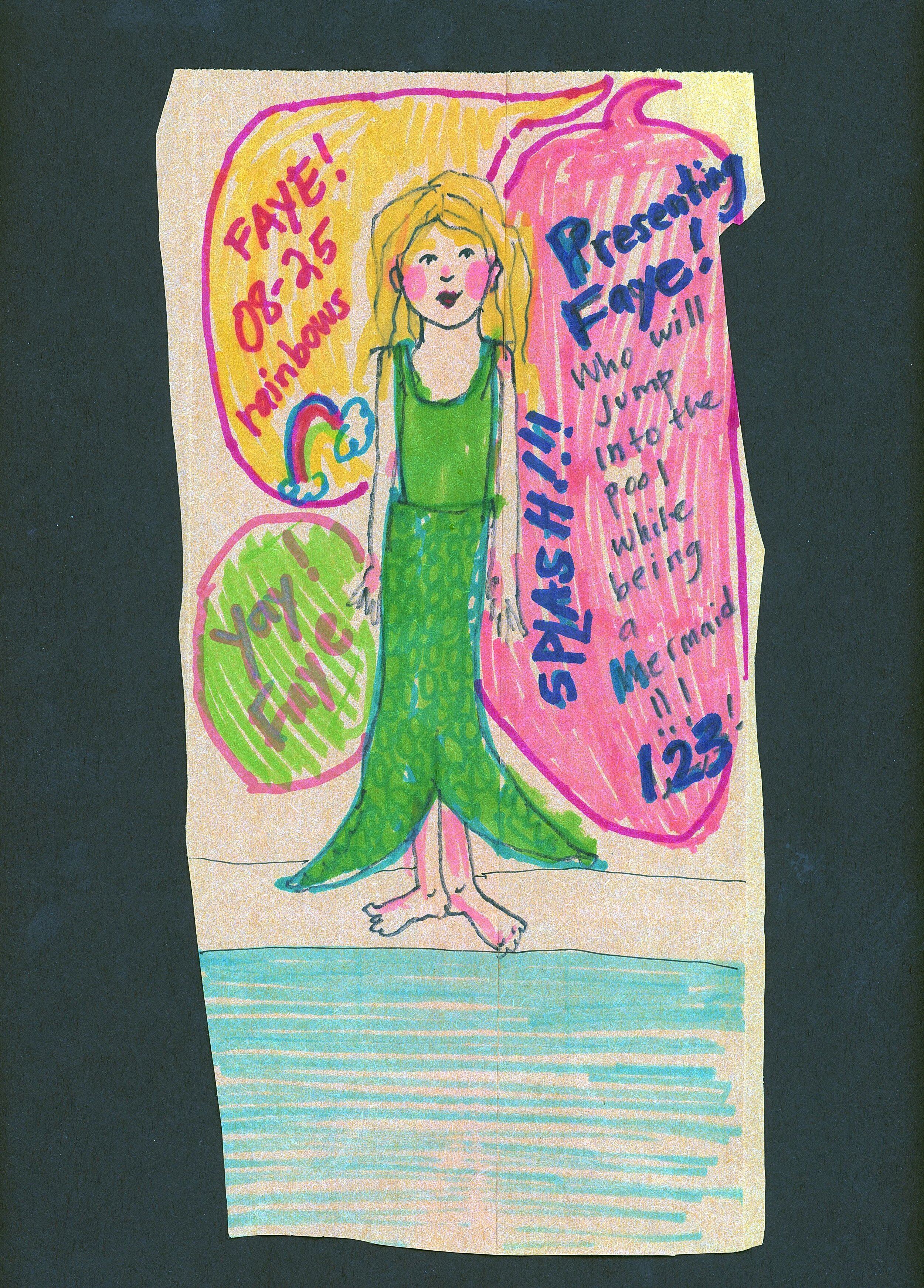
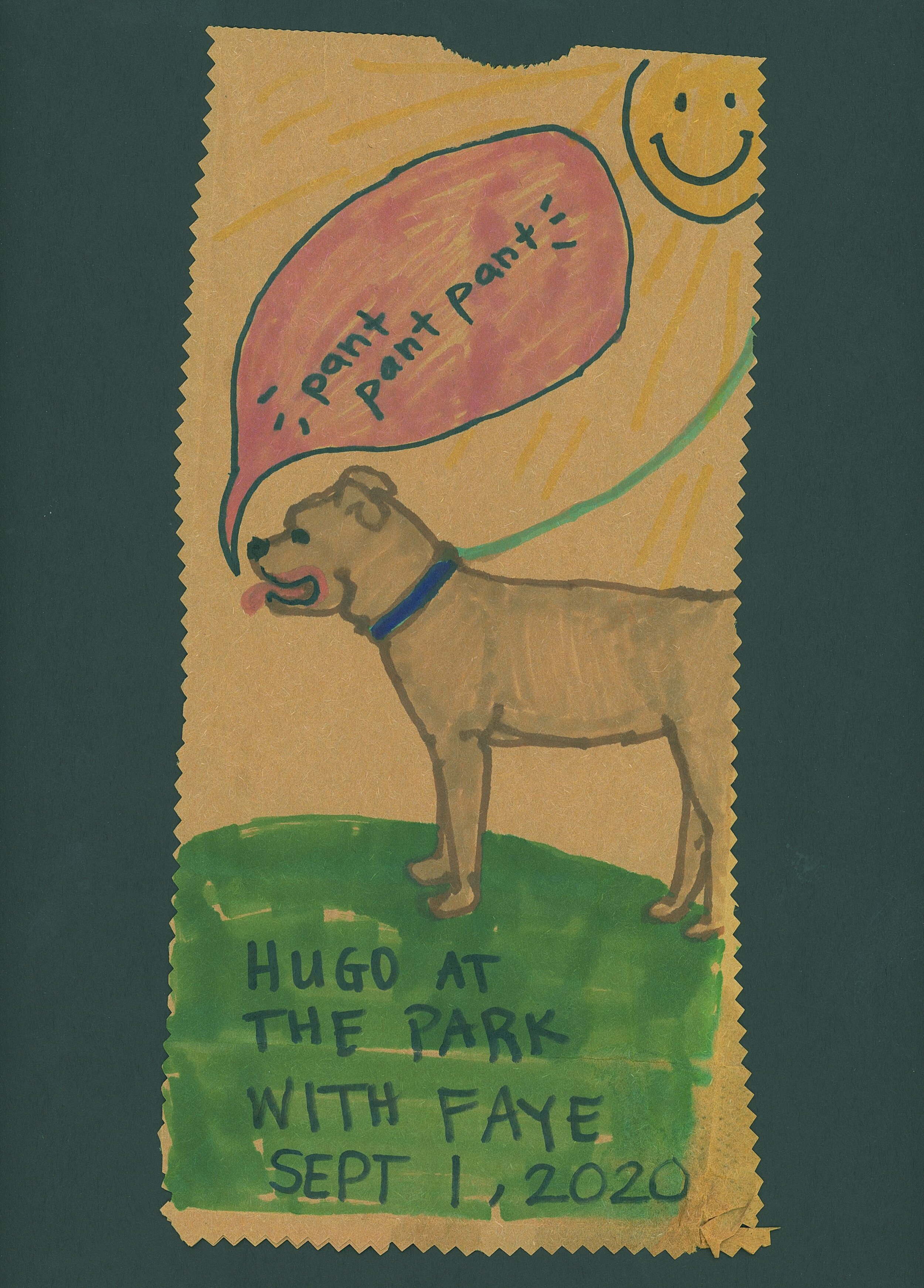
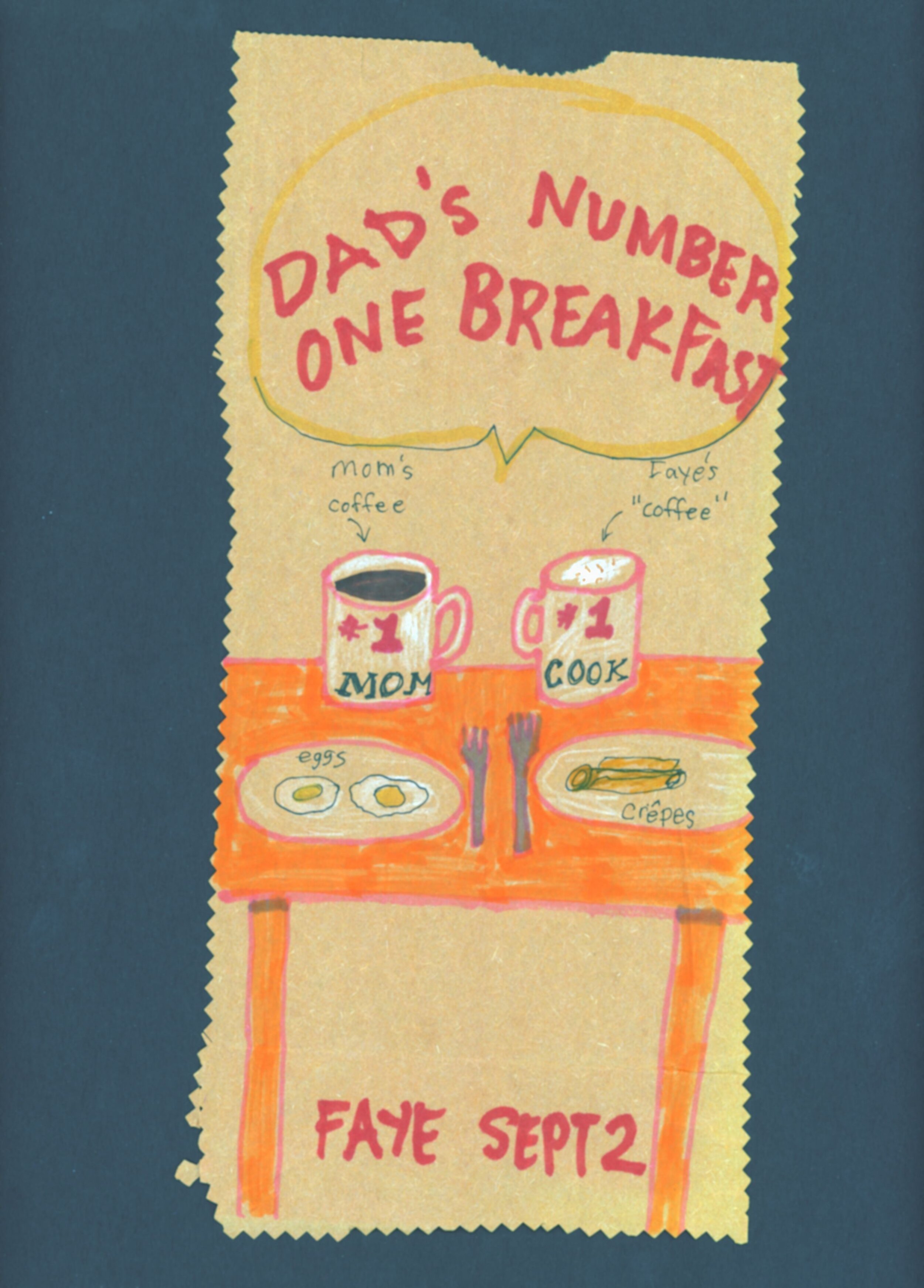
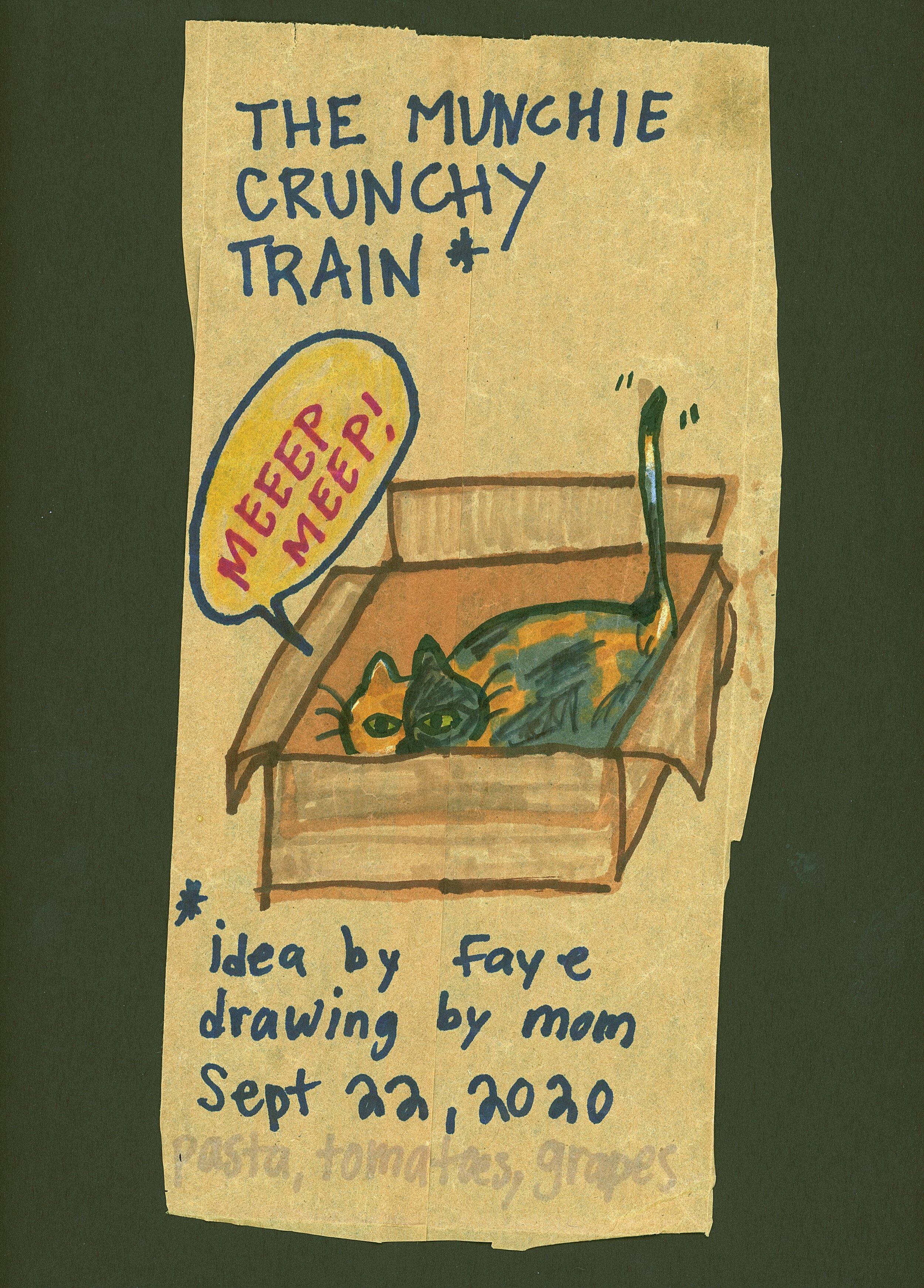
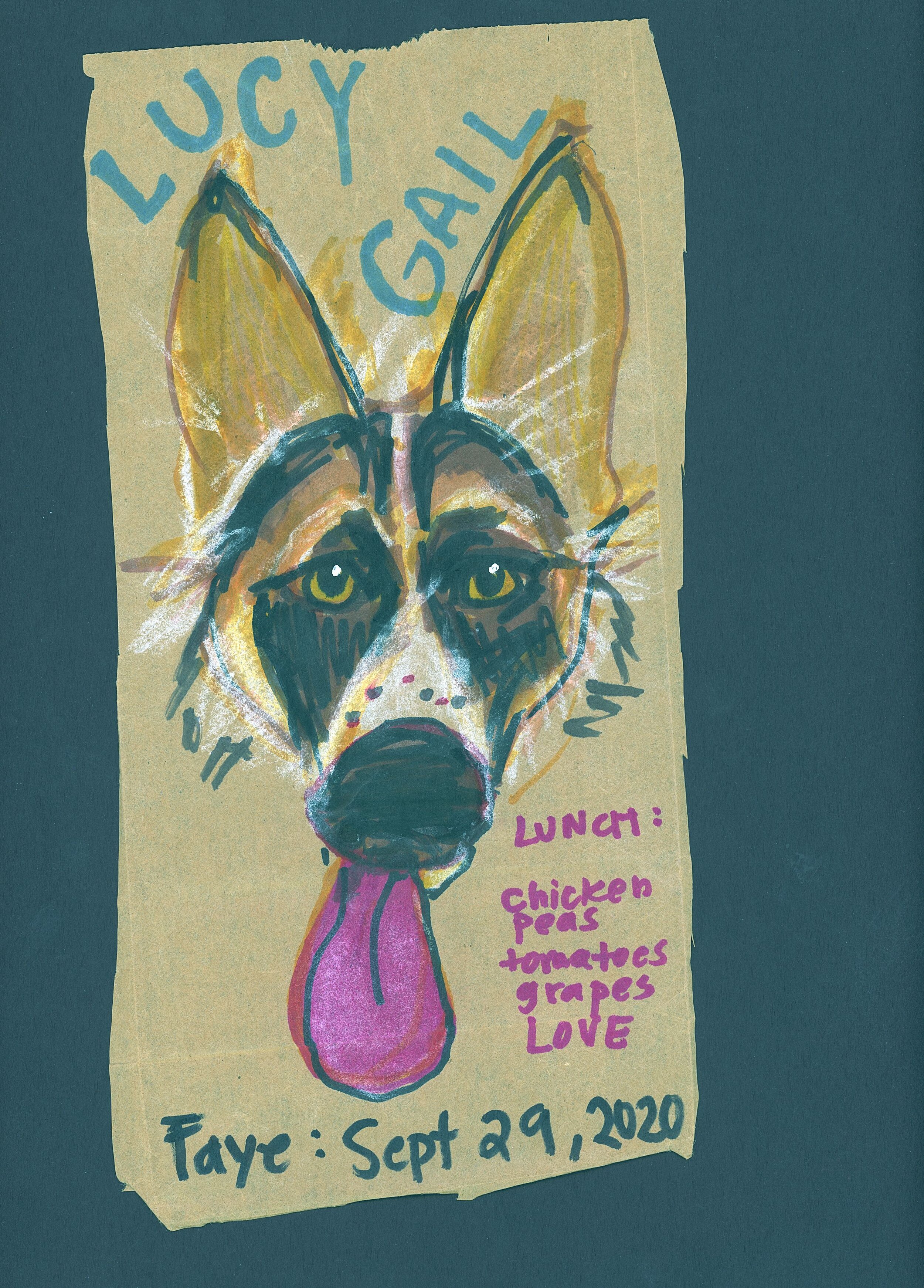
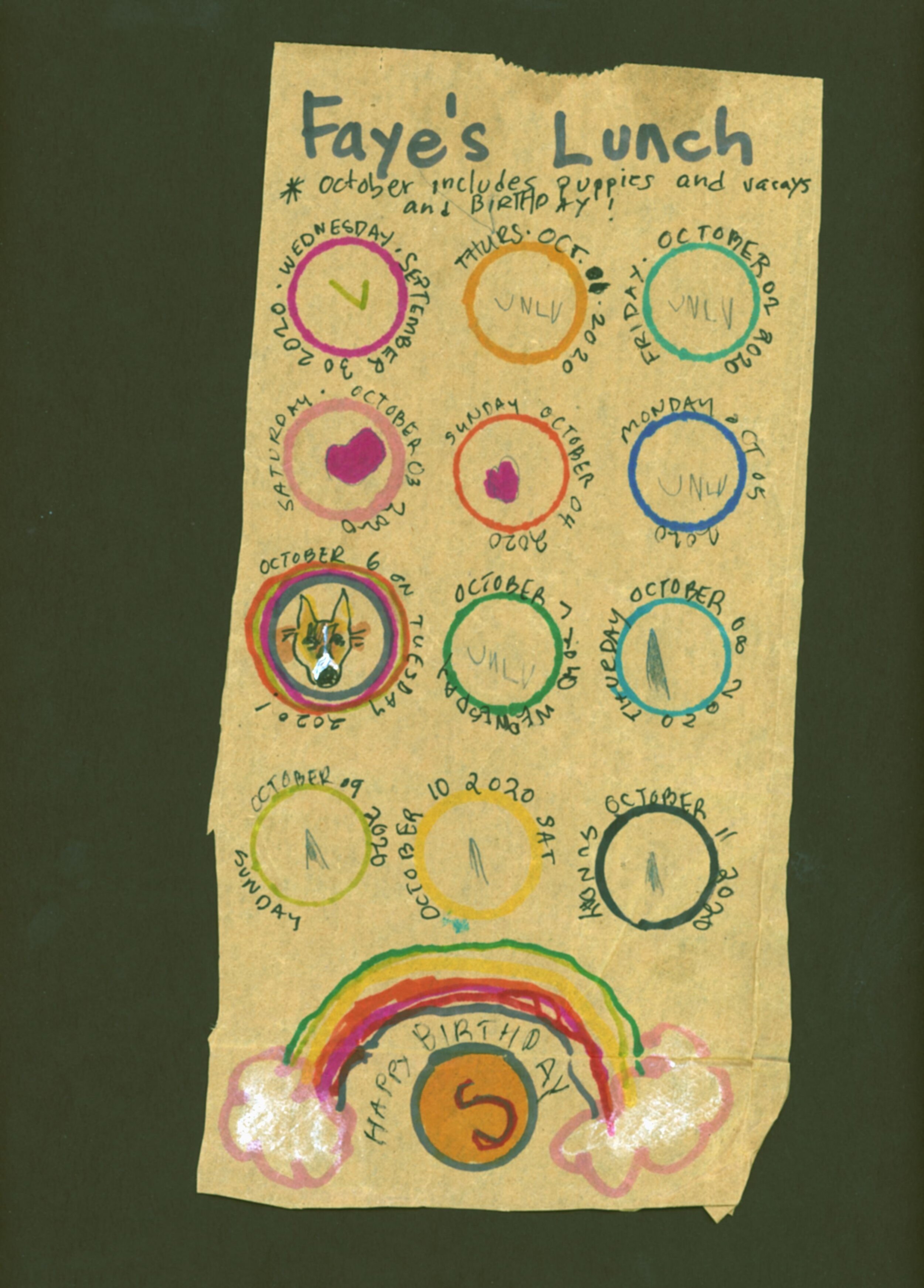
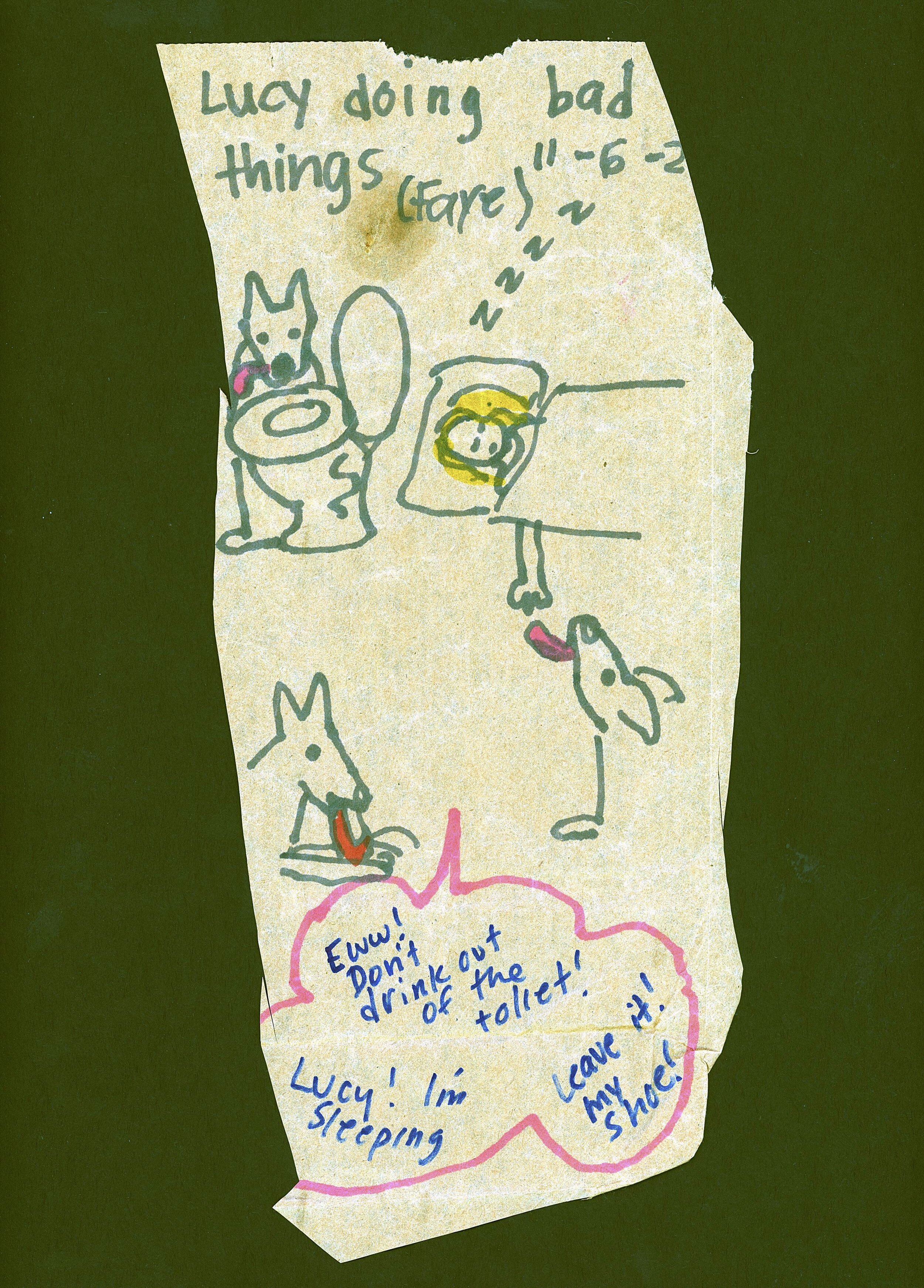
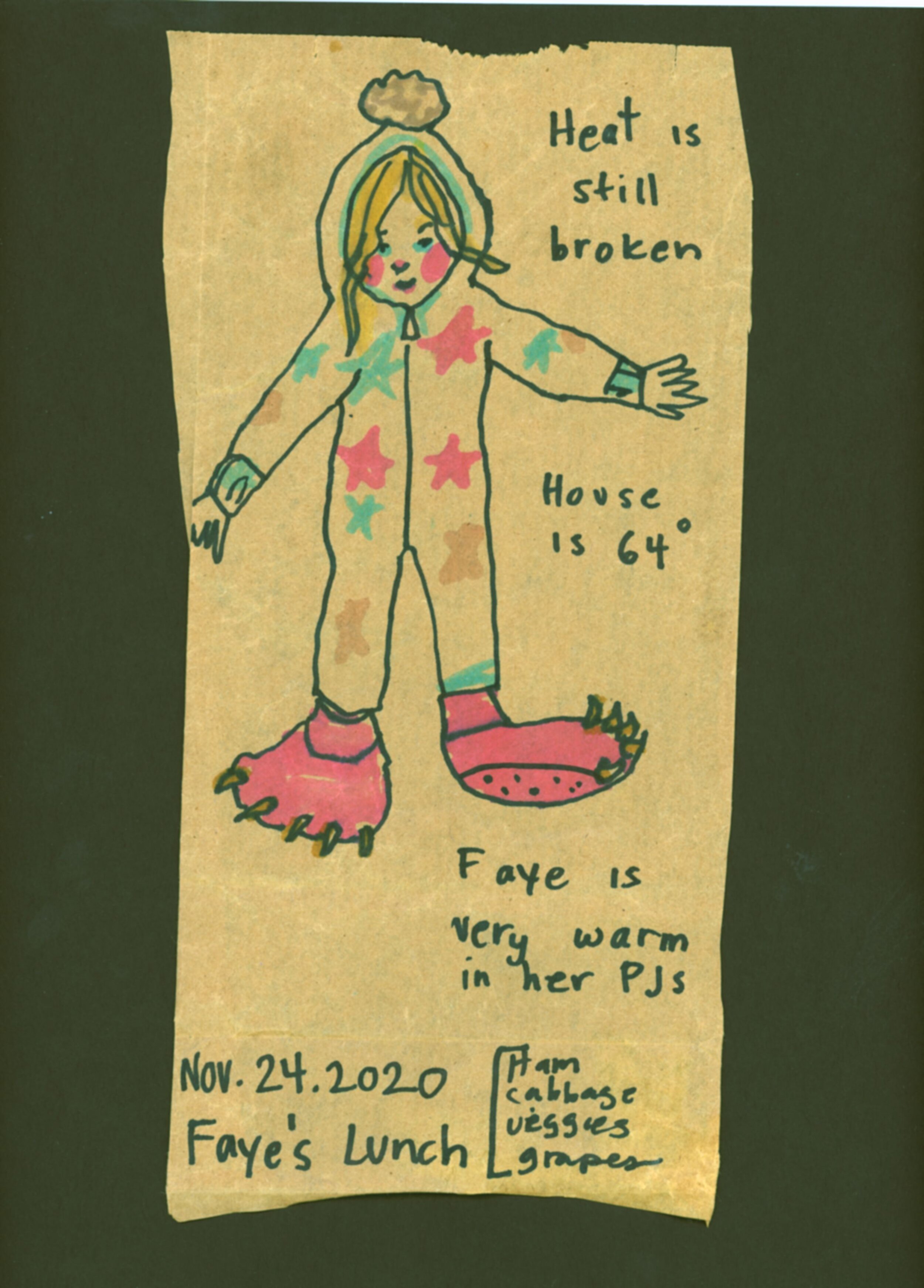
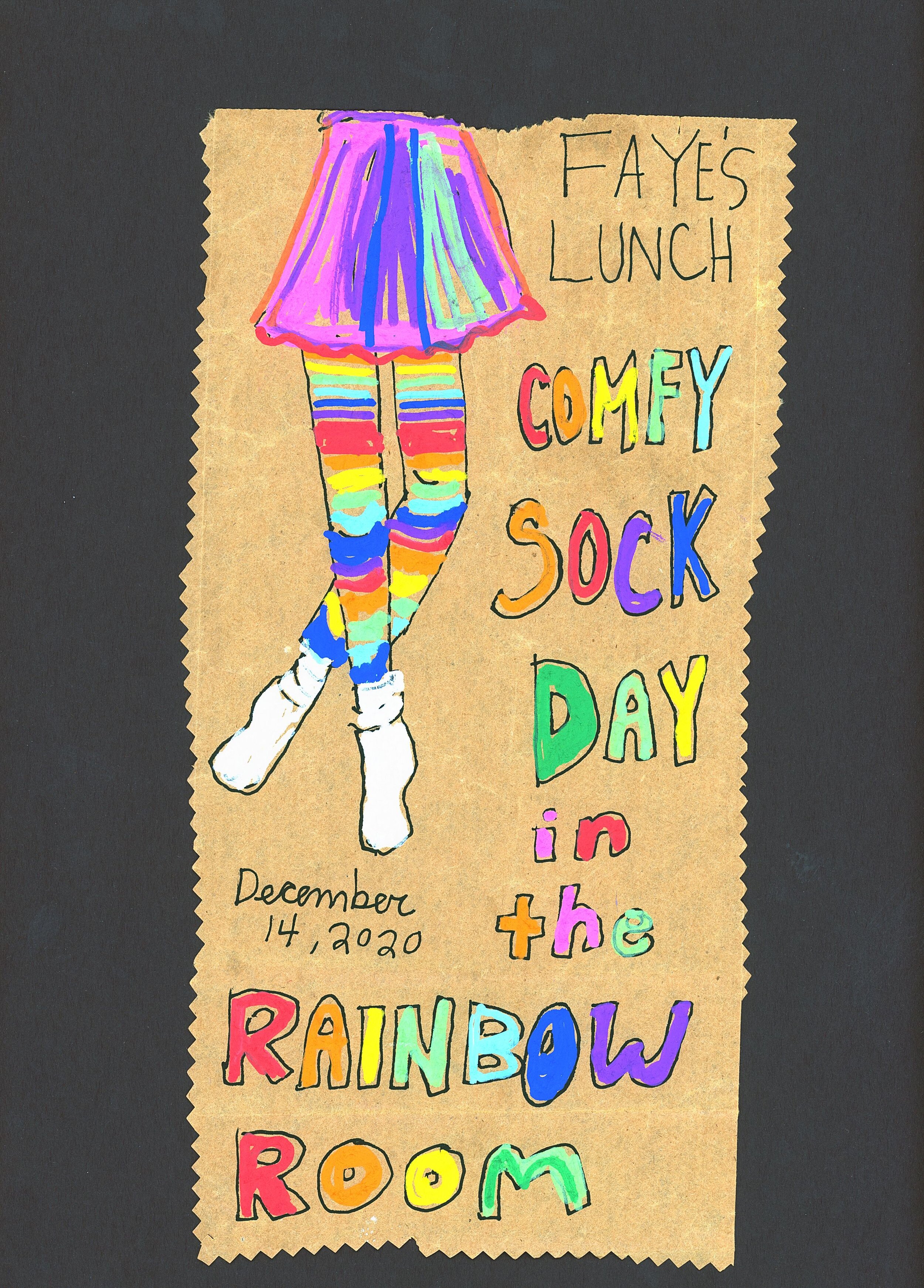
On August 13 she requested, “Draw me diving into the pool.” The day before features Annie, our calico cat, falling into the pool. The drawing requests are mostly about our goofy pets, dancing, dreams, frustrations, social anxiety, and pancake breakfasts. I think about what Ess said and know there’s more to this drawing series than sentimentality. “Our daily life holds all the answers.” I’m drawing again for the first time since becoming a director and a mother in the same year.
“I don’t experience life primarily in terms of the physical world—my emotions and memories play a much larger role in shaping my experience as a human. I know there’s a me that’s more solid than this body I move through the world in...I stick with the basic issues of human life on earth: sex, death, relationships, discovering who you are, being hurt and confused.” -Barbara Ess
This is a hard year for parents. I’m thinking of my own childhood, and hoping I am a good mother. I want to be a good director too. It’s hard. My own art practice becomes an important way for me to cope. Sometimes I’m a sad sack.
Faye drawing about pink sparkly dresses and friends sticking their tongues out and laughing.
Faye is also learning to express herself through art. Some days she draws her own lunch bags. In February, she sketched a frowny portrait of herself in pink, “I can’t wear that because my friends will laugh at me,” she explains. The object on the right is “a mouth with a tongue sticking out.” I understand what she means. I love art that both helps us gain understanding of ourselves and assists us in understanding others.
This is the year I allowed art making to become part of my daily life. I also allowed daily life to become part of the art I make—imperfect, quick, gestures made to acknowledge the roles others have in my life. I use fragments from family conversations for the text in my paintings. I collaborate with artists and writers. I send letters. I collect coffee mugs and junk mail. Childhood memory is a big part of the work, as is my role as a mother. If I am being present, my job as museum director leaks in as well. It’s a hard year to be a museum director, and my team is everything.
March 16, 2020: The museum closes. We move Lake, the museum fish, to a WFH setup.
March 17, 2020: I have a fever. I can’t get tested. I’m sick for the next five or six weeks. The fatigue is real.
March 18, 2020: We launch Pandemic Drawings and ask our friends and followers to make a drawing a day. We post every single one on @unlvmuseum. Over the next several days, over a thousand artists and their drawings respond to prompts like “draw your most intense feelings” or “draw your daily commute before the quarantine” or “draw a place you want to be, real or imaginary” or “draw your breakfast.”
August 17, 2020: The museum reopens to the public by appointment with Kept to Myself. Ashley Hairston Doughty’s inner thoughts and diary of what people say to her are installed 10 feet tall.
In November, I started cranking out new paintings at our family table. Pandemic Drawings inspired me to make something every day. Ashley’s work inspires me to write down my own thoughts and to record what others say to me.
Faye asks me, “Do clouds get sick?” I am not sure where her questions come from, but I write them down and paint them. “Why doesn’t time go backwards, Mom?
In February, I exhibited a project at ASAP titled Content May Settle that consisted of over 150 little paintings made at our kitchen table. They were installed on top of grocery store ads and junk mail that I had collected during the pandemic. I am so thankful that I was able to find the artist-side of myself again with the support of my family and friends (this could easily be a love letter to our resilient and supportive Las Vegas arts community). For the first time, I feel as if I am able to be more myself.
July 31, 2020: “Draw me talking to Grammy and Grampy.”
August 6, 2020: “Draw me visiting Lady and Billy.”
August 11, 2020: “Draw me getting a letter from Mimi and Poppy.”
December 30, 2020: Faye yells back at me from atop the mountain she’s climbed at Lake Mead. “What is perspective, Mom?”

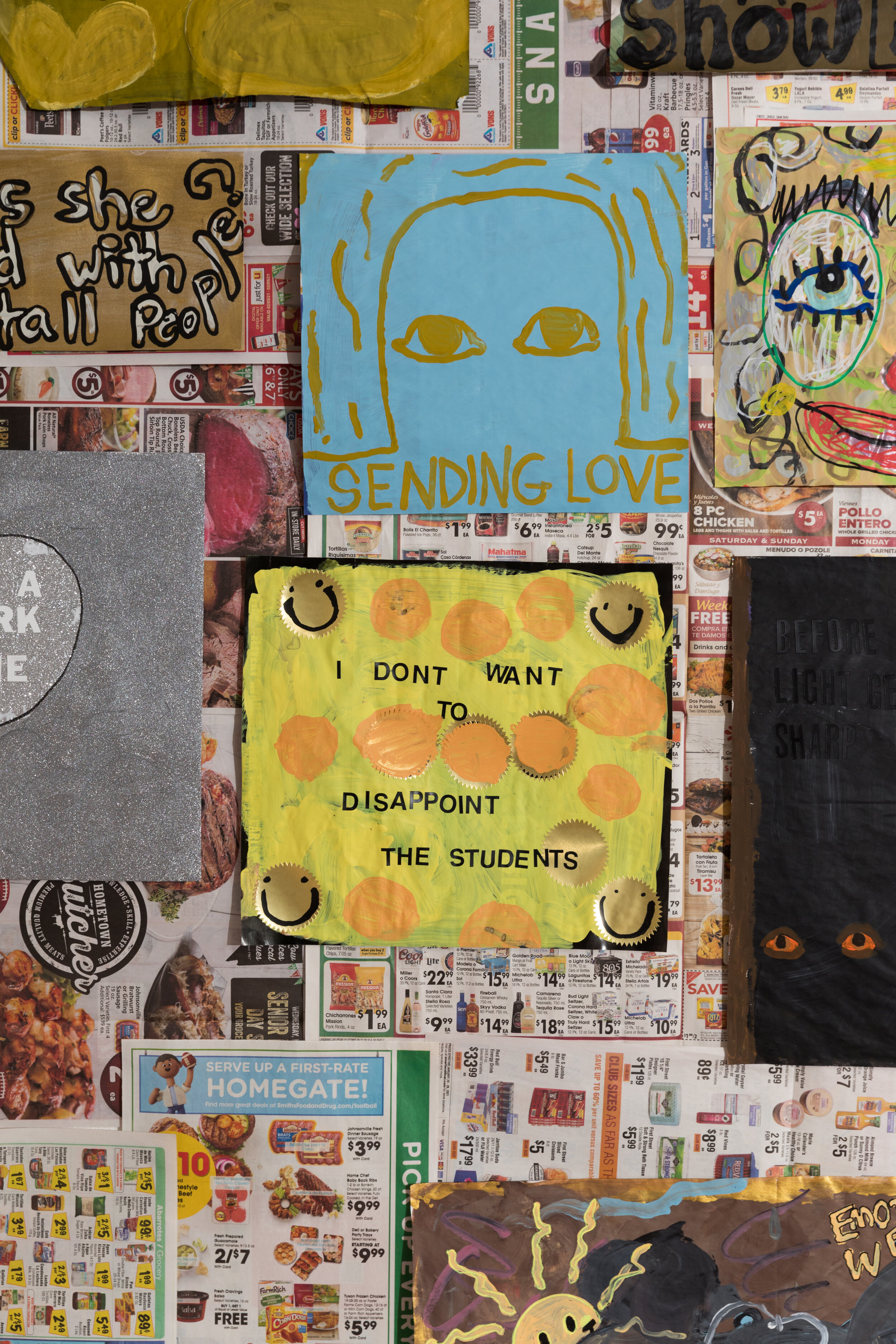
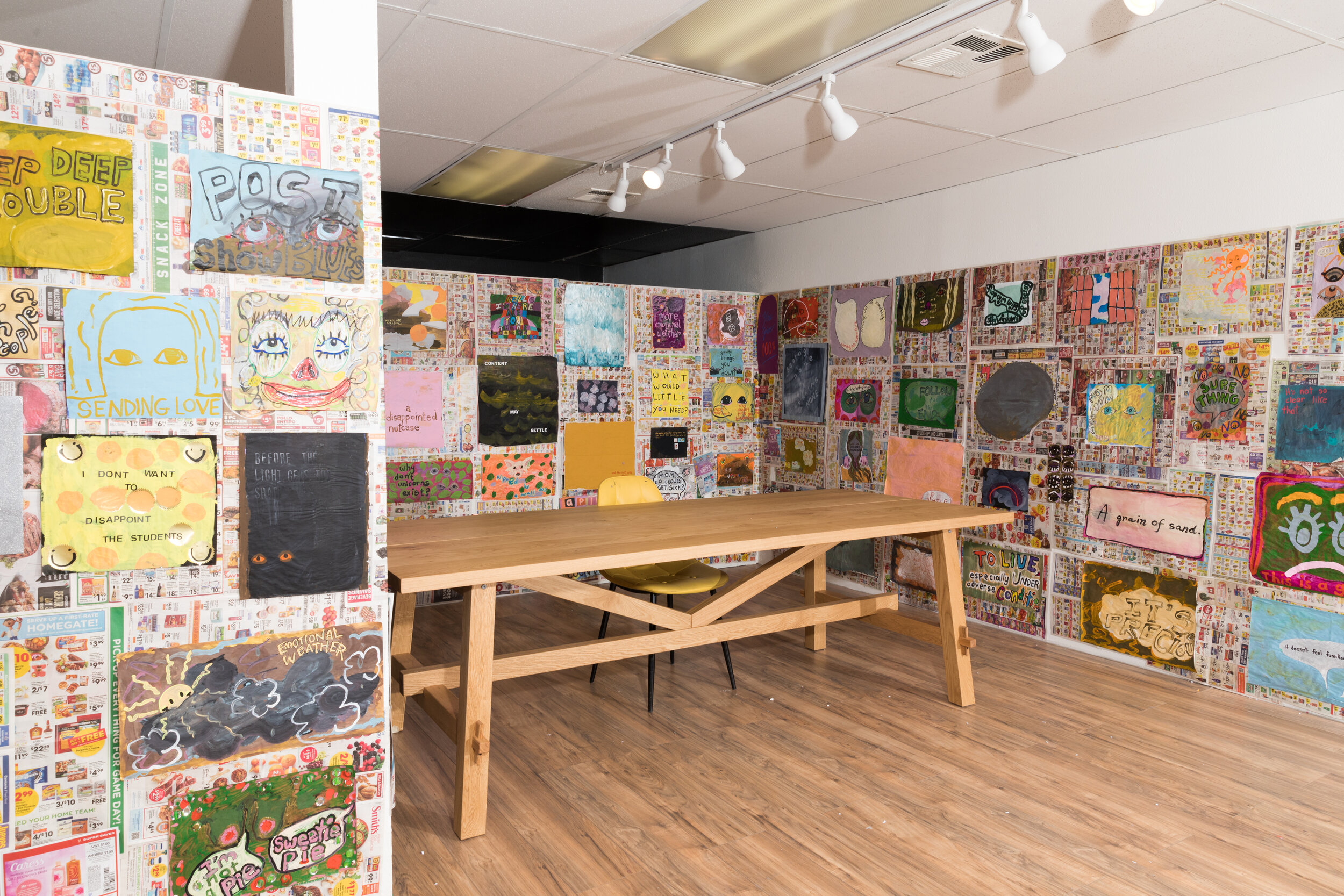
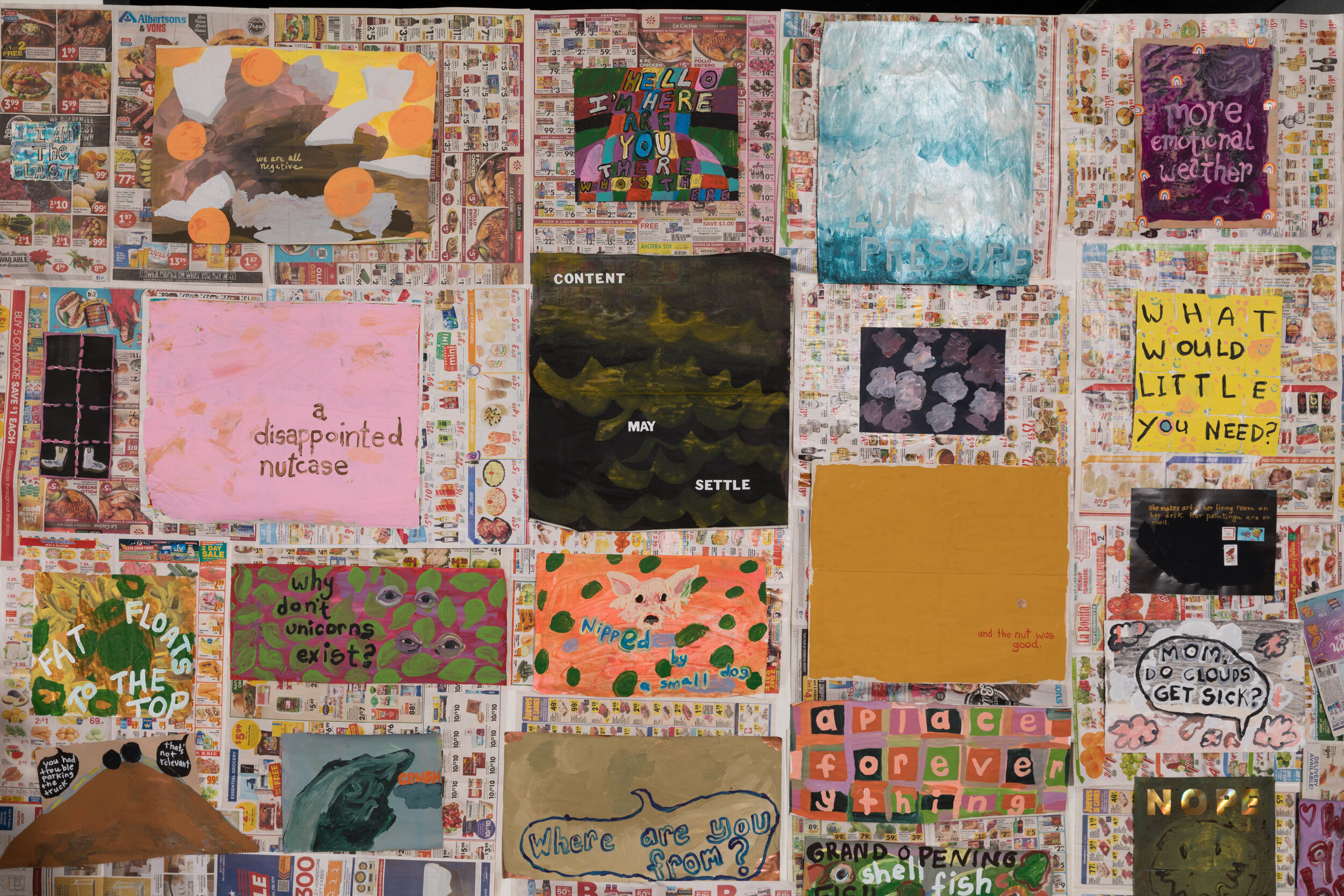
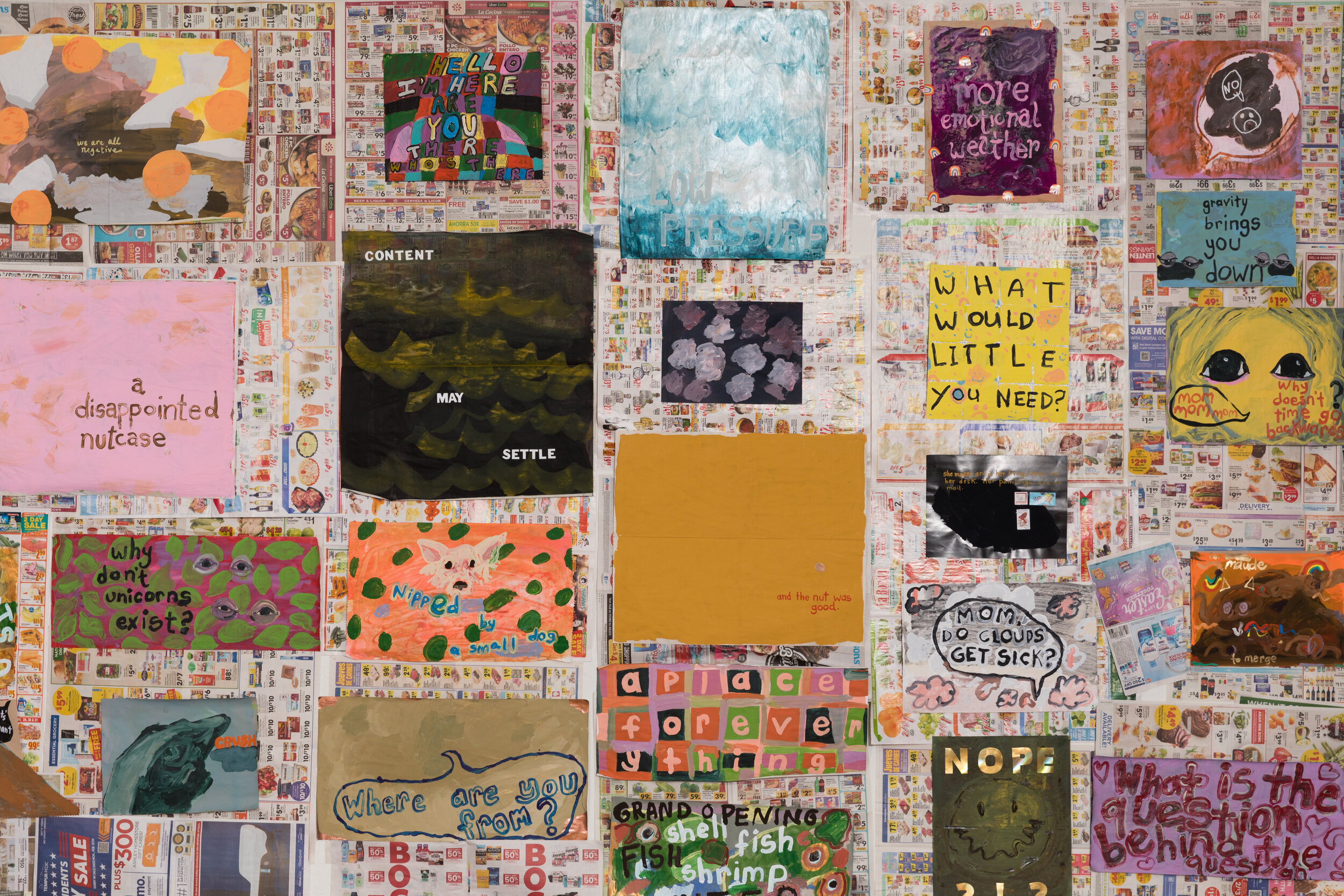
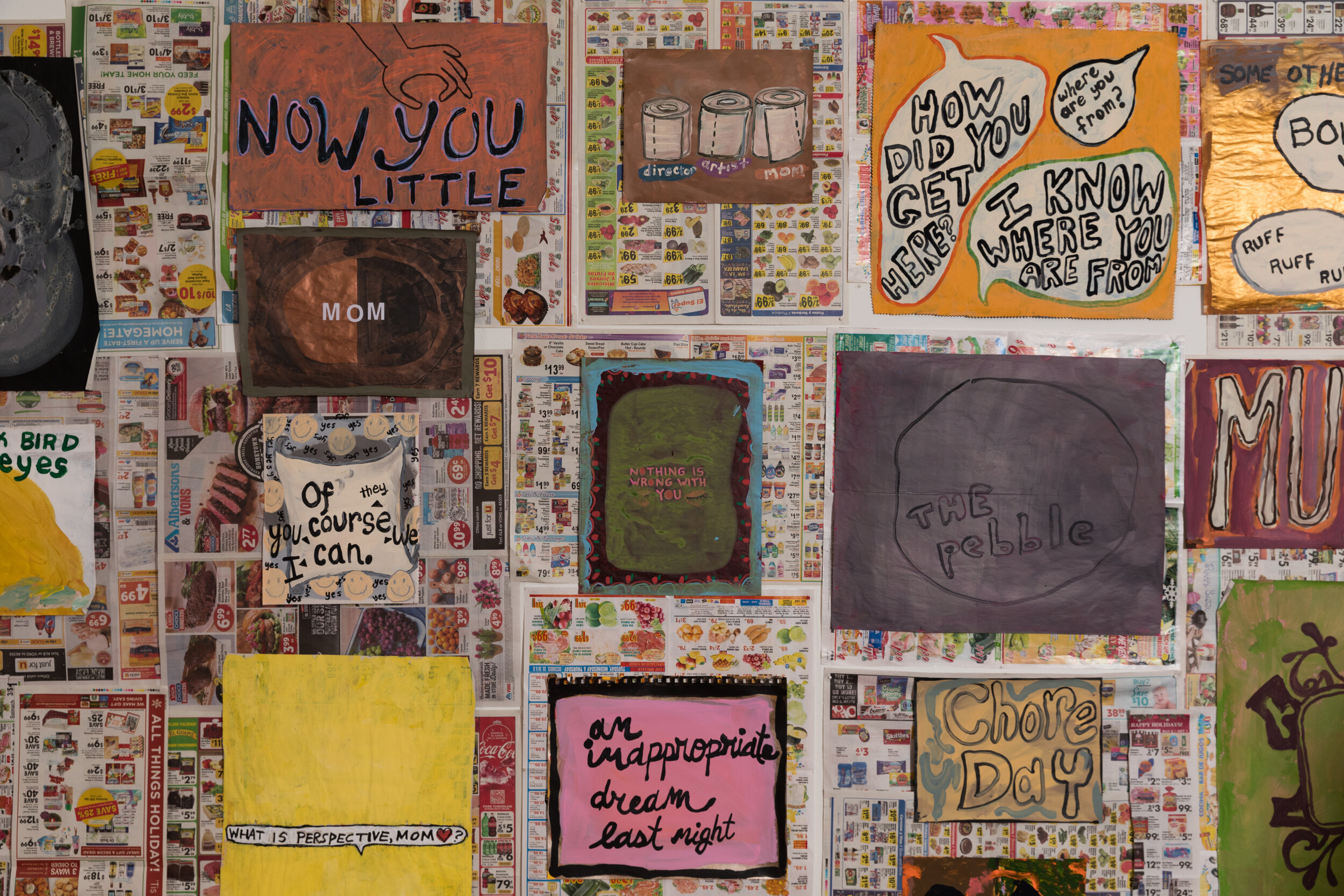
Photo/Mikayla Whitmore.
Alisha Kerlin's work in direction and curation is informed by her background as a working artist. A graduate of the Milton Avery Graduate School of Arts, Bard College (MFA), and the University of Tennessee, Knoxville (BFA), Kerlin’s own artwork has been shown at institutions ranging from P3Studio at The Cosmopolitan, Las Vegas, to the Museum of Modern Art’s PS1 Museum in New York. She lives and works in Las Vegas, Nevada, with her family. Kerlin is the Executive Director of the Marjorie Barrick Museum of Art.
Learn more about Alisha’s work at the Marjorie Barrick Museum of Art at www.unlv.edu/barrickmuseum. For more about her personal artwork at www.akerlin.com.
Thank you for visiting Humanities Heart to Heart, a program of Nevada Humanities. Any views or opinions represented in posts or content on the Humanities Heart to Heart webpage are personal and belong solely to the author or contributor and do not represent those of Nevada Humanities, its staff, or any donor, partner, or affiliated organization, unless explicitly stated. At no time are these posts understood to promote particular political, religious, or ideological points of view; advocate for a particular program or social or political action; or support specific public policies or legislation on behalf of Nevada Humanities, its staff, any donor, partner, or affiliated organization. Omissions, errors, or mistakes are entirely unintentional. Nevada Humanities makes no representations as to the accuracy or completeness of any information on these posts or found by following any link embedded in these posts. Nevada Humanities reserves the right to alter, update, or remove content on the Humanities Heart to Heart webpage at any time.






